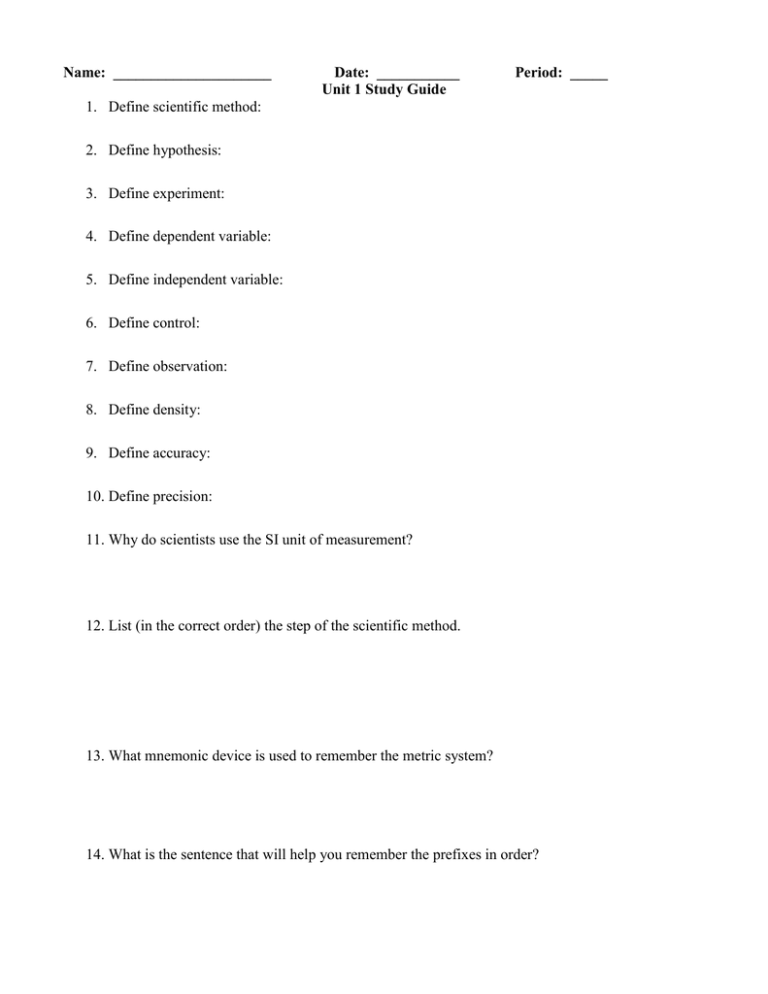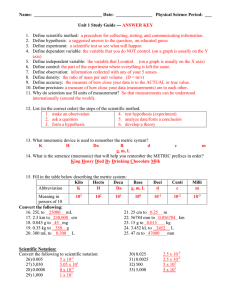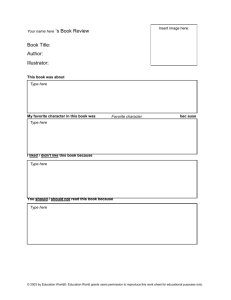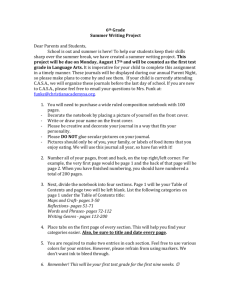Unit 1 Study guide
advertisement

Name: _____________________ Date: ___________ Unit 1 Study Guide Period: _____ 1. Define scientific method: 2. Define hypothesis: 3. Define experiment: 4. Define dependent variable: 5. Define independent variable: 6. Define control: 7. Define observation: 8. Define density: 9. Define accuracy: 10. Define precision: 11. Why do scientists use the SI unit of measurement? 12. List (in the correct order) the step of the scientific method. 13. What mnemonic device is used to remember the metric system? 14. What is the sentence that will help you remember the prefixes in order? 15. Fill in the table below describing the metric system: Kilo Hecto Deca Base Deci Centi Milli Abbreviation. Meaning in powers of 10: Convert the following: 16. 25L to _____________mL 21. 25 cm to ______________ m 17. 2.3 km to ____________ cm 22. 56784 mm to ___________ km 18. 0.045 g to __________ mg 23. 15 g to _______________ kg 19. 0.35 kg to ____________g 24. 3.452 kL to _______________ L 20. 300 mL to ____________ L 25. 47 m to _____________mm Scientific Notation: Convert the following to scientific notation: 26. 0.005 ______________ 30. 0.025______________ 27. 5,050______________ 31. 0.0025______________ 28. 0.0008______________ 32. 500______________ 29. 1,000______________ 33. 5,000 ______________ Convert the following to standard notation: 1) 1.5 x 103 ______________ 5) 1.2 x 10-4 ______________ 2) 3.75 x 10-2 ______________ 6) 1 x 104 ______________ 3) 2.2 x 105 ______________ 7) 1 x 10-1 ______________ 4) 3.35 x 10-1 ______________ 8) 4 x 106 ______________ Density: Solve the following density problems: 𝑴𝒂𝒔𝒔 𝑴 𝒐𝒓 𝑫 = 𝑽𝒐𝒍𝒖𝒎𝒆 𝑽 1) What is the density of carbon dioxide gas if 0.196g occupies a volume of 100 mL? 𝑫𝒆𝒏𝒔𝒊𝒕𝒚 𝑬𝒒𝒖𝒂𝒕𝒊𝒐𝒏: 𝑫𝒆𝒏𝒔𝒊𝒕𝒚 = 2) An irregular shaped stone was lowered into a graduated cylinder holding a volume of water equal to 10mL. The height of the water rose to 17mL. If the mass of the stone was 25g, what is the stone’s density? 3) A 10cm3 sample of copper has a mass of 89.6g. What is the density of copper? 4) A sample of iron has the dimensions 2cm x 3cm x 2cm. If the mass of this rectangular shaped object is 94g, what is the density of iron? Safety 1) What MUST you when working with chemicals, heat or class ware? 2) What 2 safety equipments/items are available in a science class room? 3) When can you use each piece of safety equipment in problem 2? 4) Correct the following safety rules a. Eating and drinking is permitted in the laboratory. b. It is safe to look into a container that is being heated. c. If you do not understand a direction you should just guess at what to do. d. Unauthorized experiments are safe to do. Graphs 1. What type of data is graphed with a line graph? 2. What type of data is graphed with a bar graph? 3. What type of data is graphed with a circle graph? 4. On the “Favorite sport” graph what is the dependent variable? 5. On the “Favorite sport” graph what is the independent variable? 6. On the “Favorite sport” graph what is the favorite sport? 7. On the “Scores on Math SAT” graph what tests have the two closest scores? 8. On the “Scores on Math SAT” graph what test has a score of 600? 9. On the “temperature vs day” graph what is the dependent variable? 10. On the “temperature vs day” graph what is the independent variable?





